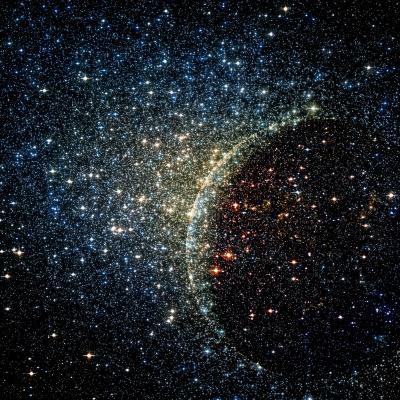Anúncios
The Identification of the Cosmic Microwave Background (CMB) as a Remnant of the Big Bang Is a Crucial Milestone in Modern Cosmology
It represents the first light emitted by the universe when it became transparent to radiation. Studying this radiation allows us to look billions of years into the past.
Through detailed observations, scientists detect signals that confirm the Big Bang theory. These data reveal temperature fluctuations that reflect the initial structure of the cosmos. This enables us to understand how the universe evolved into what we know today.
Anúncios

How Does the Identification of the Cosmic Microwave Background as a Remnant of the Big Bang Work?
The identification of the Cosmic Microwave Background (CMB) as a remnant of the Big Bang is a monumental achievement in the field of cosmology. The CMB is a faint glow of microwave radiation that fills the universe and is considered one of the main pieces of evidence supporting the Big Bang theory. This radiation is a relic of the early universe, specifically from a time when the universe was only about 380,000 years old. At that stage, the universe had cooled enough for protons and electrons to combine and form neutral hydrogen atoms, allowing photons to travel freely without being scattered. This event is known as “recombination,” and the photons released during this period constitute the CMB we observe today.
The process of identifying the CMB involves sophisticated observation techniques and instruments. Ground-based and space telescopes are employed to detect these faint microwave signals. The most notable instruments include the Wilkinson Microwave Anisotropy Probe (WMAP) and the Planck satellite, which mapped the CMB with incredible precision. The data collected by these missions reveal small temperature fluctuations across the sky, corresponding to regions of varying density in the early universe. These fluctuations provide critical insights into the formation of galaxies and large-scale structures in the universe, enabling scientists to reconstruct the evolution of the cosmos from its origin to the present day.
To effectively identify the CMB, researchers use a combination of theoretical models and observational data. Theoretical physics helps predict the characteristics of the CMB, while observational data confirm these predictions. By analyzing the CMB spectrum, scientists can determine its temperature, which is approximately 2.7 Kelvin. This temperature is remarkably uniform across the sky, with slight anisotropies that offer clues about the conditions of the early universe. Identifying the CMB as a remnant of the Big Bang not only reinforces the Big Bang theory but also opens paths to explore fundamental questions about the universe’s origin, composition, and ultimate fate.
What Is the Cosmic Microwave Background

The CMB is a microwave radiation that fills the universe almost uniformly. It was generated about 380,000 years after the Big Bang, when the universe had cooled enough. At that point, atoms formed and photons could travel freely.
The existence of this radiation confirms that the universe had a hot and dense beginning. It is one of the strongest pieces of evidence for the Big Bang theory. Its detection revolutionized our understanding of the cosmos’ origin.
Furthermore, the CMB functions as a visual record of the early universe. The small variations in its temperature show the seeds of current galaxies. These anisotropy patterns have been mapped with high precision.
Finally, the cosmic microwave background is considered a “fossil” of the early universe. Studying it is fundamental to validate cosmological models. It offers a direct view of a time that cannot be observed any other way.
How the CMB Was Discovered
The discovery of the CMB was accidental, made in 1965 by scientists Penzias and Wilson. They detected a constant noise in their radio antennas. This noise came from all directions and could not be eliminated.
Soon, scientists realized it was radiation coming from deep space. It was the radiation predicted by the Big Bang theory, which had not been confirmed until then. This discovery earned the Nobel Prize in Physics in 1978.
Since then, new missions have been launched to study the CMB in more detail. Satellites like COBE, WMAP, and Planck mapped its distribution with precision. These data showed the temperature fluctuations that explain galaxy formation.
Today, the discovery of the CMB is considered a pillar of cosmology. It marked the beginning of an era of precise observations of the universe. Without it, the Big Bang theory would not have such a solid observational basis.
Advantages of Understanding the Identification of the Cosmic Microwave Background as a Remnant of the Big Bang
Understanding the identification of the Cosmic Microwave Background (CMB) as a remnant of the Big Bang offers numerous advantages that go beyond mere academic interest. First, it provides a robust framework for understanding the evolution of the universe. By studying the CMB, scientists can extract information about the conditions that prevailed in the early universe, including its temperature, density, and composition. This understanding is crucial for developing cosmological models that describe how the universe expanded and evolved over billions of years.
Secondly, the CMB serves as a tool to test various cosmological theories. Precise measurements of CMB temperature fluctuations allow researchers to compare observational data with theoretical predictions. This process can validate existing theories or highlight discrepancies that may lead to new insights. For example, the discovery of dark energy and dark matter was significantly influenced by CMB observations, leading to a deeper understanding of the universe’s composition and the forces that govern its expansion.
Furthermore, the CMB offers a unique opportunity to study the fundamental physics of the universe. Studying the CMB involves concepts from quantum mechanics, thermodynamics, and general relativity, making it a rich field for interdisciplinary research. By exploring the properties of the CMB, scientists can investigate the fundamental nature of space, time, and matter. This research not only enhances our understanding of the cosmos but also has implications for other fields, such as particle physics and astrophysics.
Finally, the CMB has inspired technological advancements in observation techniques and instrumentation. The development of sensitive detectors and sophisticated data analysis methods for studying the CMB has led to innovations that benefit other areas of science and engineering. The pioneering techniques in CMB research have been adapted for use in various applications, including medical imaging and telecommunications. Thus, the benefits of understanding the CMB go far beyond cosmology, impacting a wide range of scientific and technological domains.
How to Identify the Cosmic Microwave Background as a Remnant of the Big Bang

Identifying the Cosmic Microwave Background (CMB) as a remnant of the Big Bang involves several steps and methodologies that leverage advanced technology and scientific principles. First, researchers begin by employing sensitive microwave detectors that can capture the faint signals of the CMB. These detectors are often mounted on telescopes strategically located in areas with minimal interference from Earth’s atmosphere, such as high-altitude observatories or in space. The goal is to capture the faint microwave radiation that permeates the universe, which is approximately 2.7 Kelvin above absolute zero.
Once the data is collected, the next step involves analyzing the temperature fluctuations in the CMB. Scientists use sophisticated algorithms to process the raw data, identifying regions of varying temperature that correspond to density fluctuations in the early universe. These fluctuations are critical to understanding the distribution of matter and energy in the cosmos. The analysis often involves creating detailed maps of the CMB, which reveal the anisotropies that offer insights into the universe’s structure and evolution.
In addition, researchers compare their observational data with theoretical models of the CMB to identify key features that align with Big Bang theory predictions. This comparison is crucial for validating the identification of the CMB as a remnant of the Big Bang. By fitting the observed data to cosmological models, scientists can extract valuable parameters, such as the Hubble constant, dark matter density, and the cosmic expansion rate.
Finally, the identification process is further validated through cross-correlations with other astrophysical observations. For example, the CMB can be correlated with galaxy surveys and large-scale structure data to provide a more comprehensive understanding of the universe’s evolution. This multifaceted approach ensures that the identification of the CMB is robust and scientifically sound, reinforcing its status as a remnant of the Big Bang and a pillar of modern cosmology.
Did You Enjoy Learning About the Identification of the Cosmic Microwave Background as a Remnant of the Big Bang?
Learning about the identification of the Cosmic Microwave Background as a remnant of the Big Bang is truly fascinating. This remarkable aspect of cosmology not only deepens our understanding of the universe’s origins but also invites us to reflect on fundamental questions about existence and the cosmos. The CMB serves as a cosmic echo of the Big Bang, allowing us to glimpse the universe’s infancy and the processes that shaped it.
As we continue to explore the universe’s mysteries, the study of the CMB remains a vibrant and essential field of research. The insights gained from this exploration have the potential to unlock new avenues of knowledge and inspire future generations of scientists and thinkers. Embracing this journey of discovery can lead to an even greater appreciation of the cosmos and our place within it.
Frequently Asked Questions
What is the cosmic microwave background?
The cosmic microwave background is the light that came from the Big Bang. It is everywhere in space.
How was the cosmic microwave background discovered?
It was accidentally discovered in 1965. Scientists heard a mysterious signal with their antennas.
Why is the identification of the cosmic microwave background important?
It helps us understand how the universe began. It is proof of the Big Bang.
Can the cosmic microwave background be seen with the naked eye?
No, you can’t see this radiation. But it can be measured with special equipment.
What can we learn from identifying the cosmic microwave background?
We can learn about the age of the universe and how stars formed. It’s a way to look into the past!
